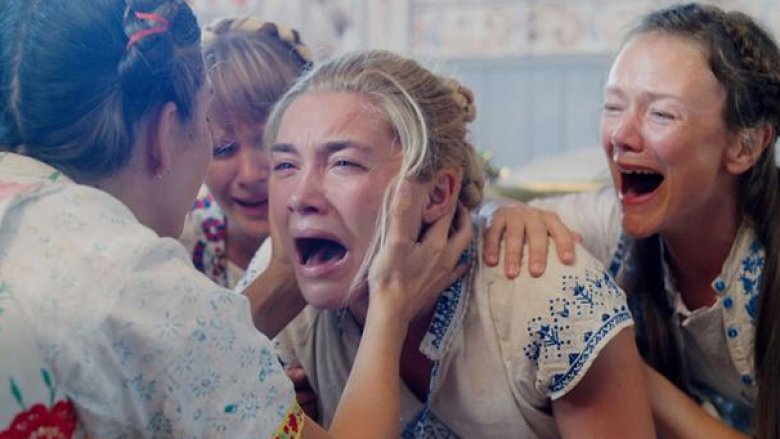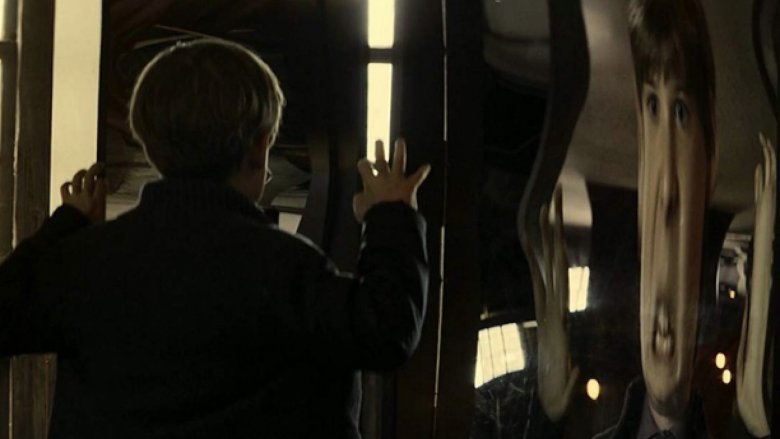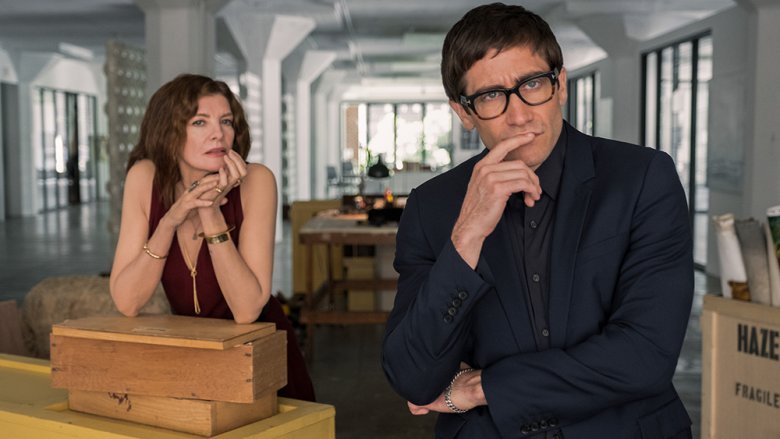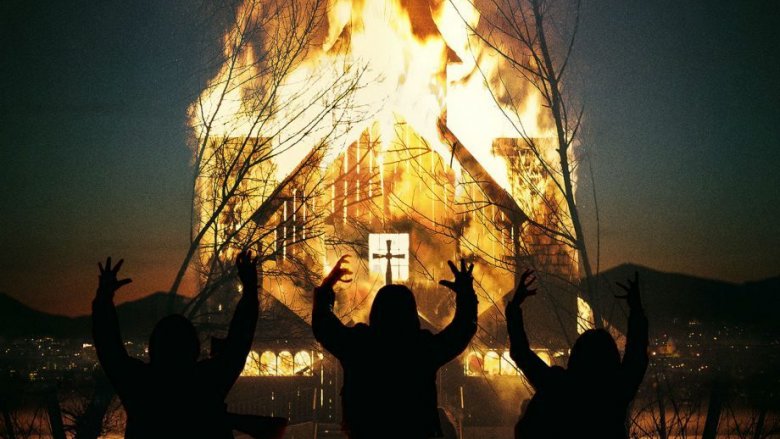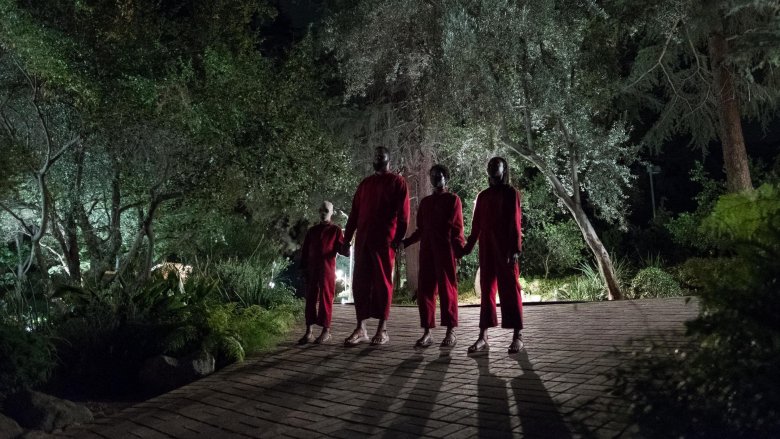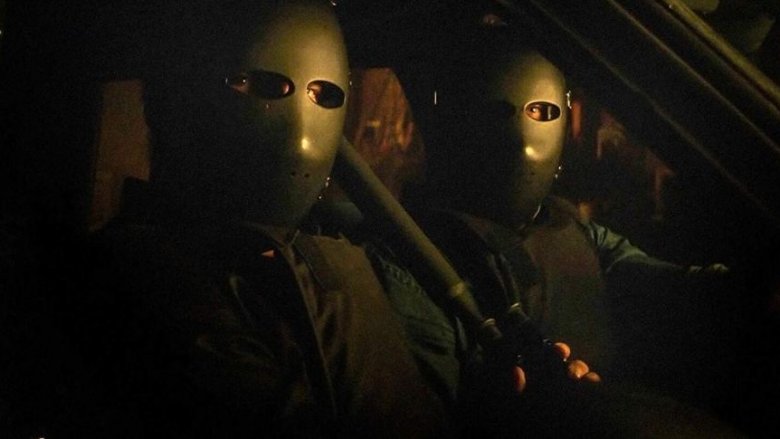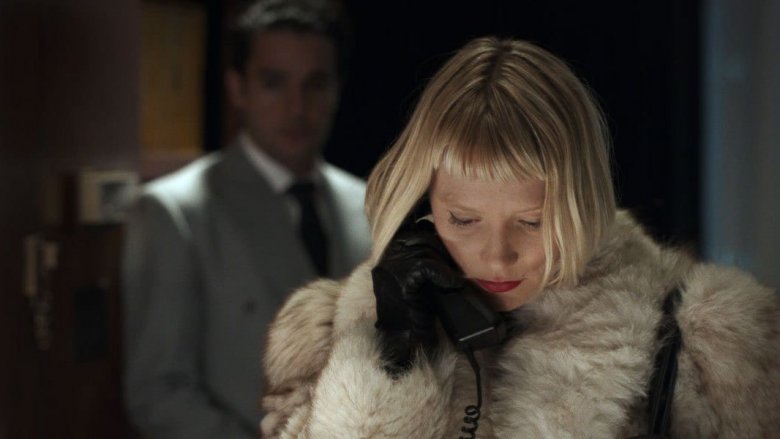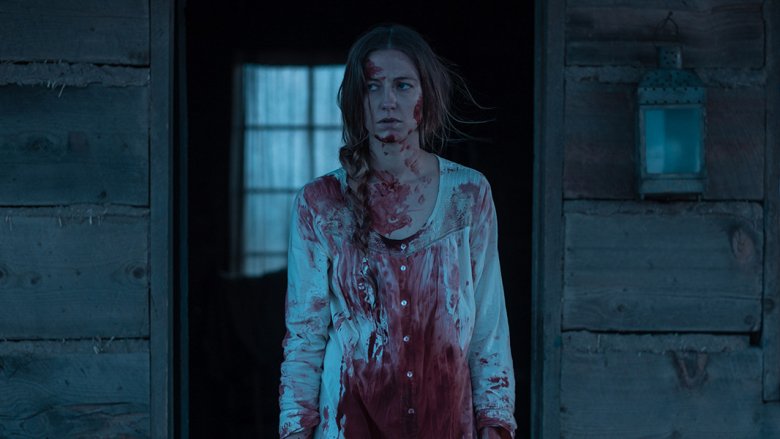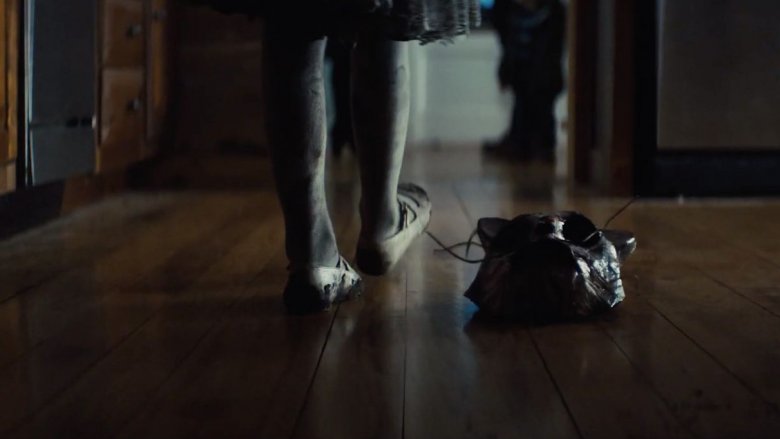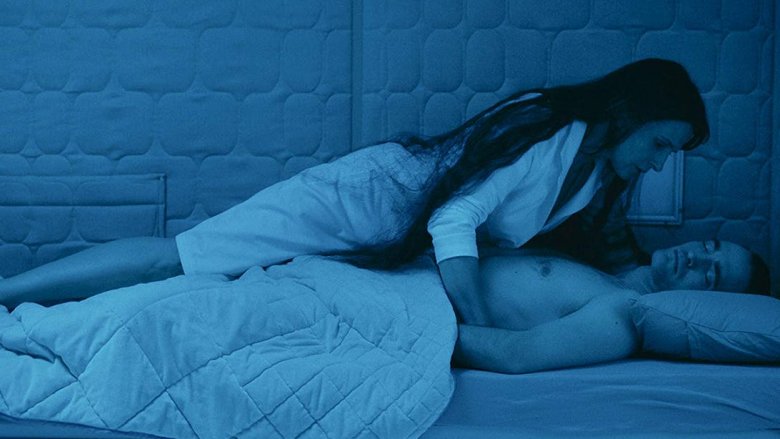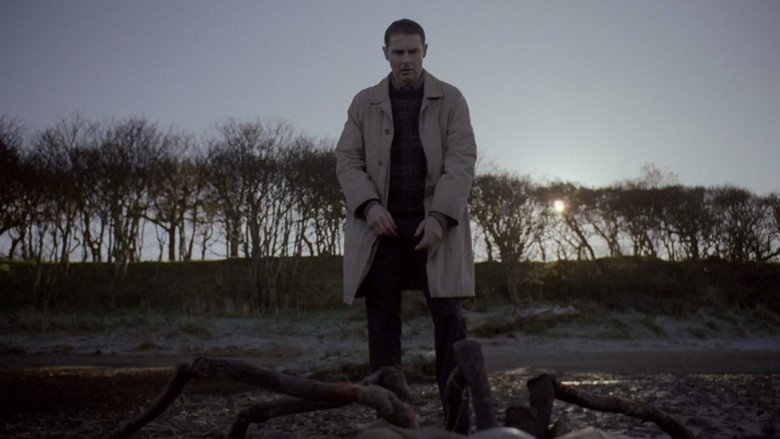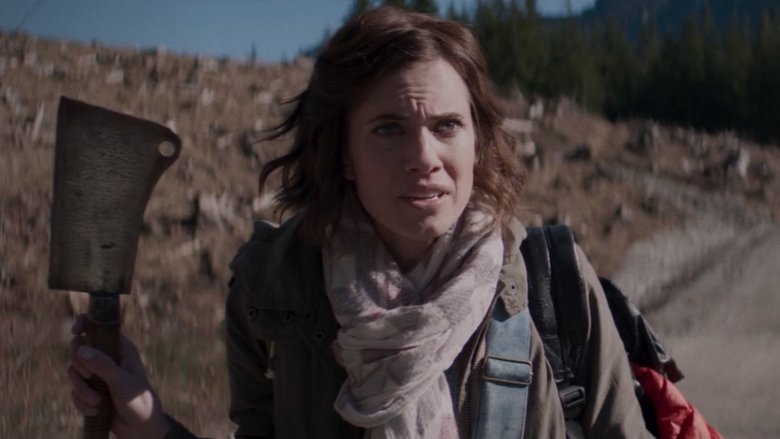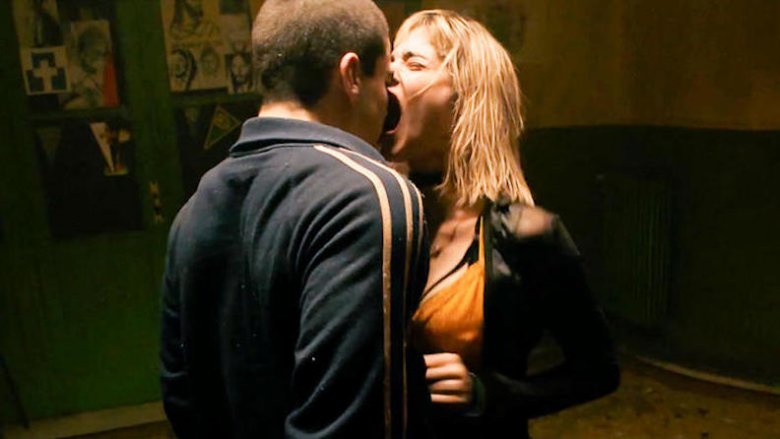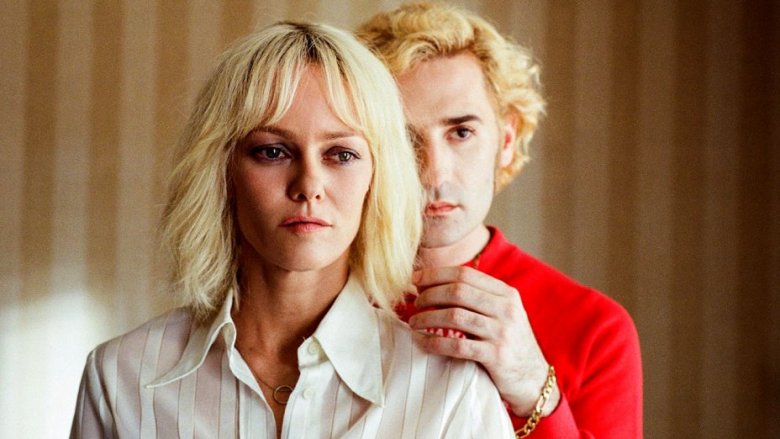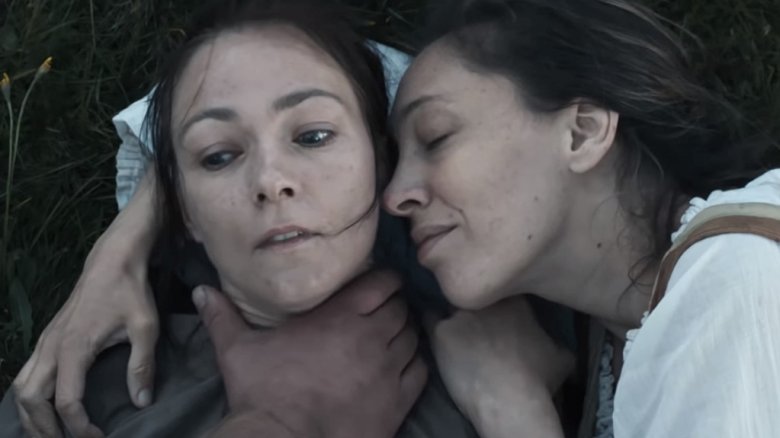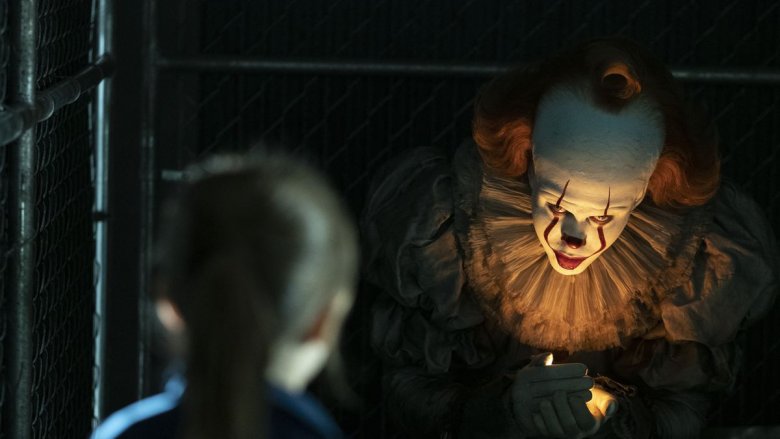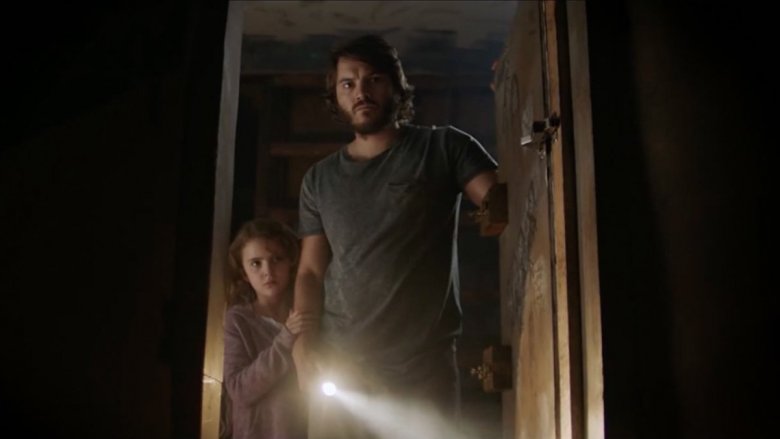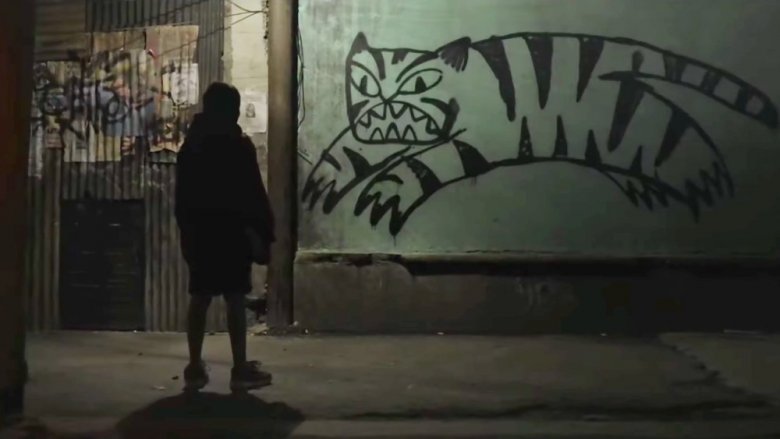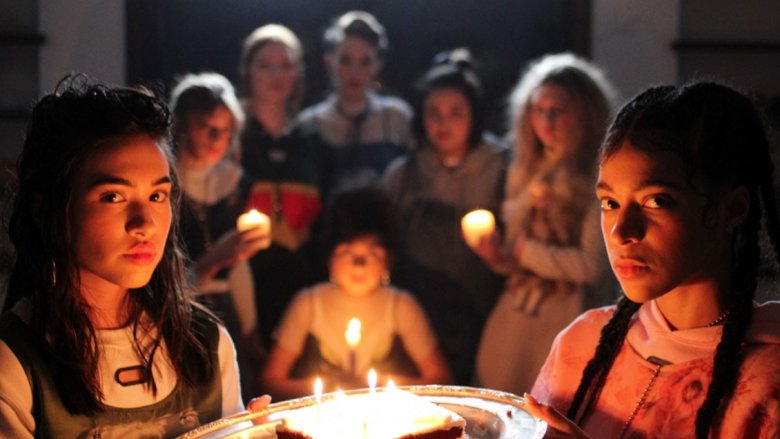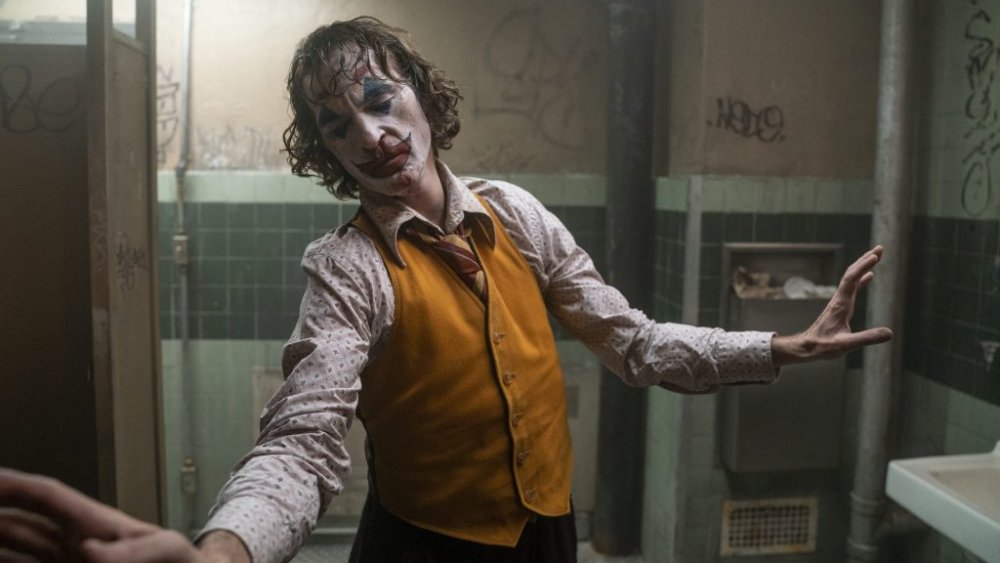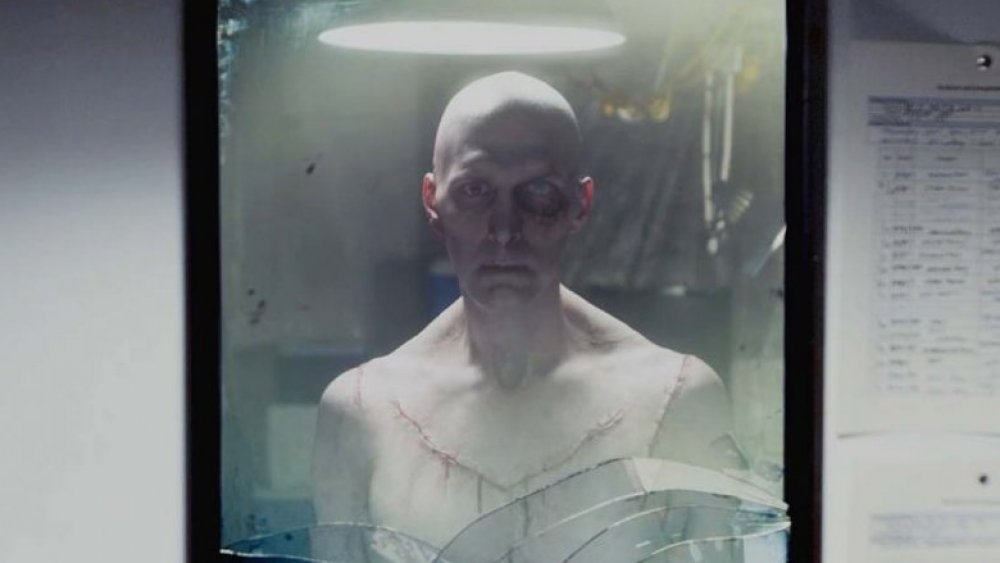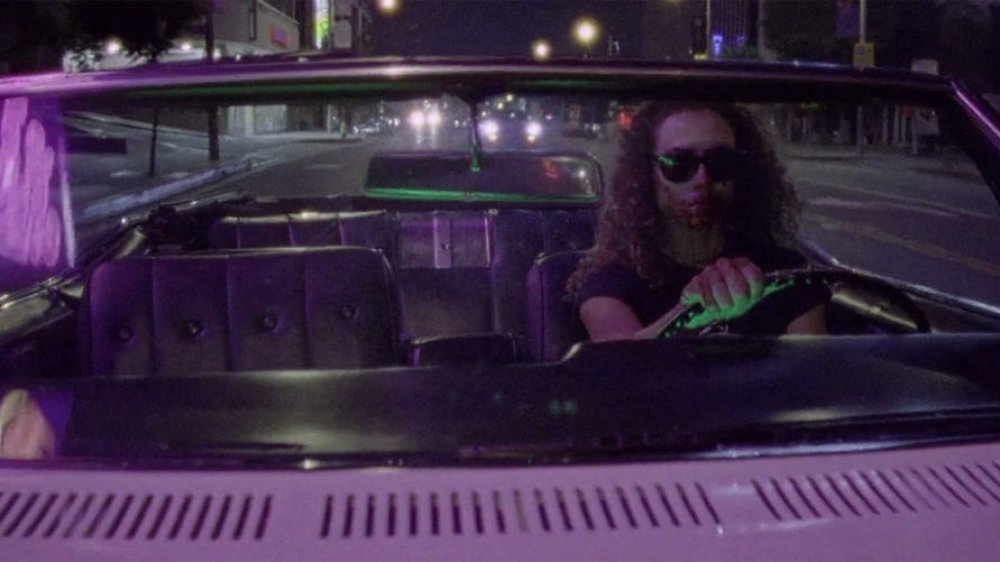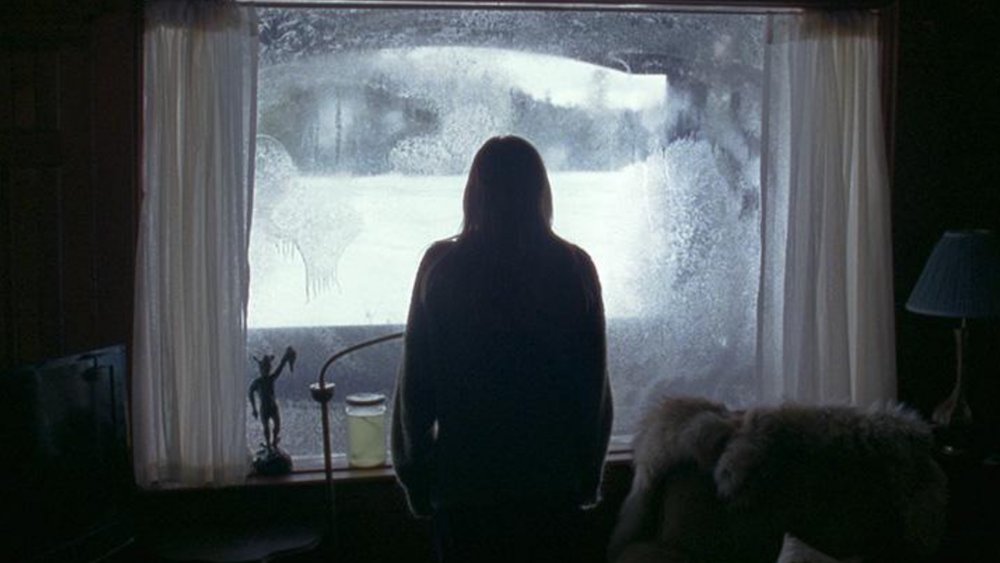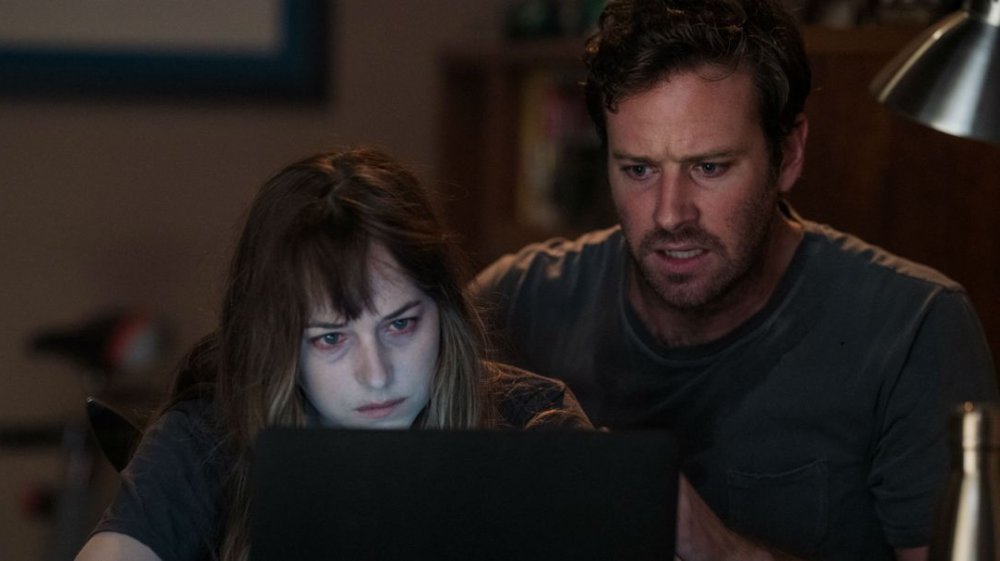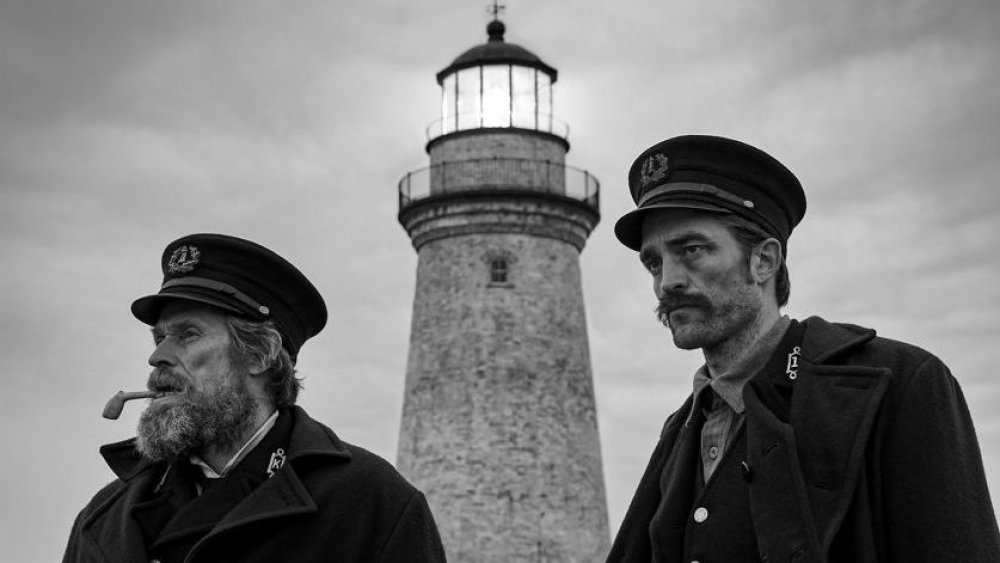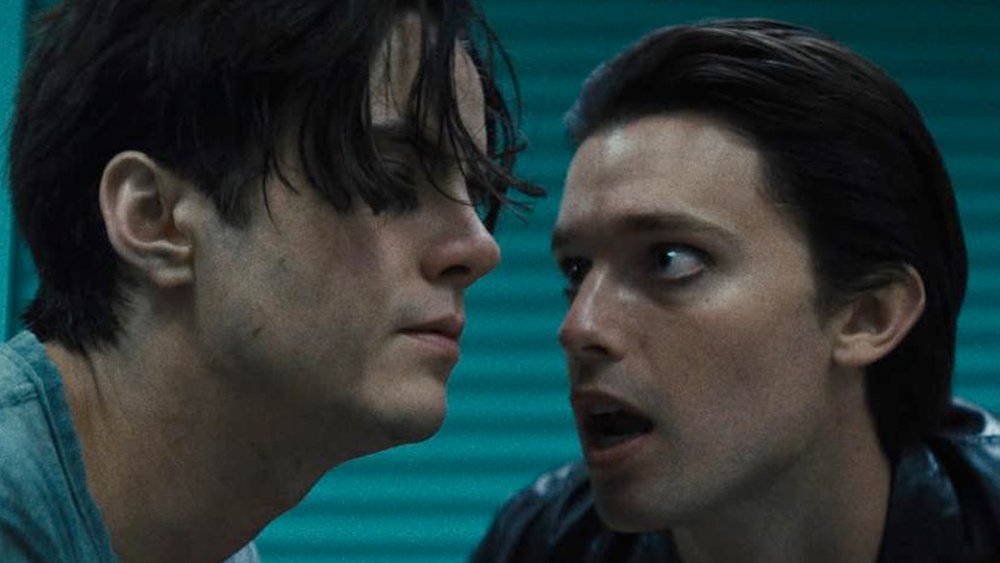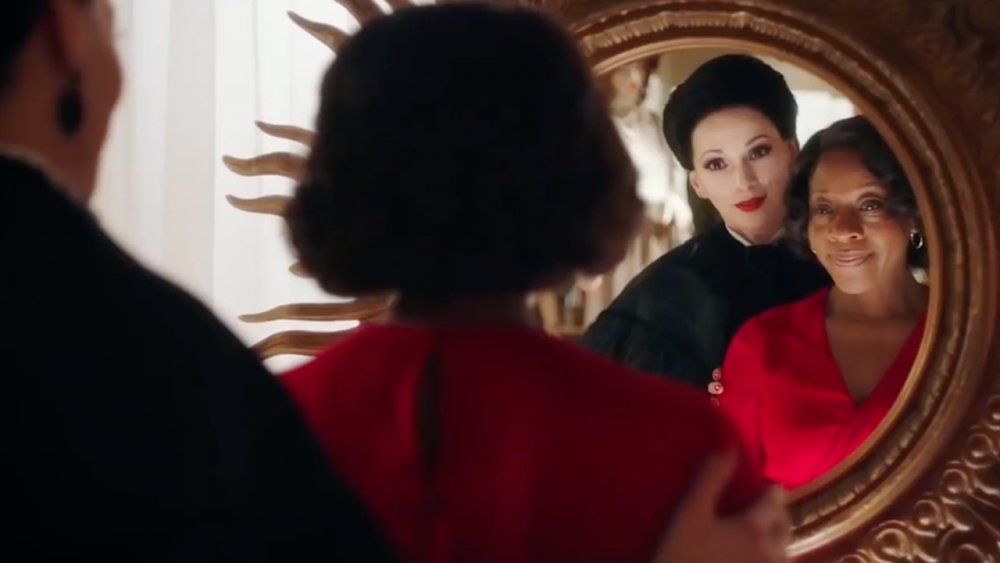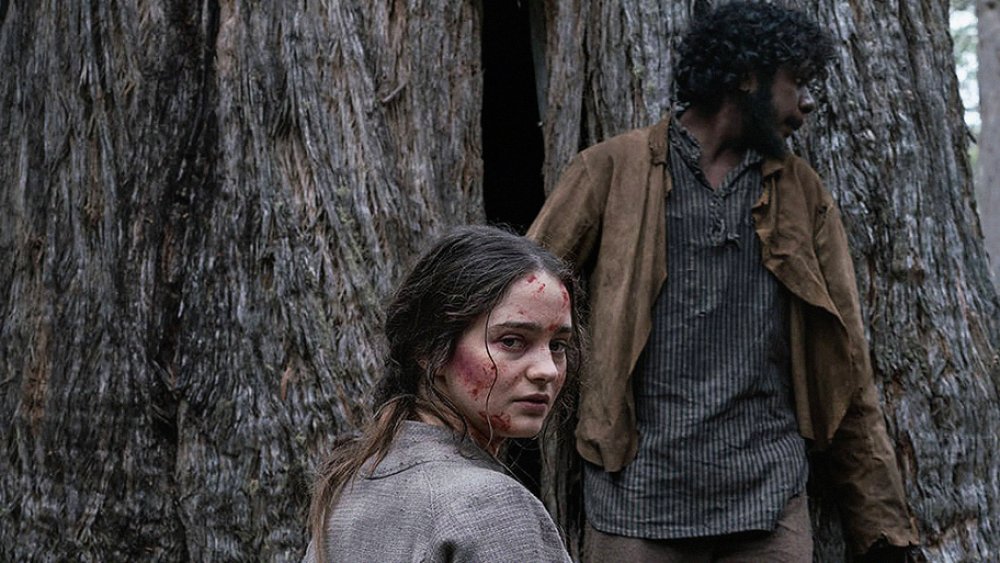The Most Disturbing Movies Of 2019
People like to quip about how often life tends to imitates art (or vice versa), and how cinema in particular can serve as a mirror image of the world not just as it is, but as it might become. If either of those points of view can be taken at face value, then the world we're living in is more than a little bit fractured. Perhaps more worrisome than that unsettling fact is that all manner of wicked things seem to be working their way through the ever-widening fissures.
However you choose to view the world, there's little doubt that a broad swathe of fears, uncertainties, social strifes, and inherent paranoias are helping guide those evil things to the surface. In turn, they're also driving the narratives for some of the more intriguing (and most disturbing) big screen confections in recent years. Those same complex topics and themes are behind some of 2019's most challenging works as well. As the year continues to deliver a potent slate of movies possessed of unholy terrors, nefarious characters, and beastly delights, we're happy to chronicle each and every one of them for you. These are the most disturbing movies of 2019.
The Hole in the Ground
Since its founding less than a decade ago, A24 Films has transformed itself from the little indie studio that could into a bonafide indie powerhouse. They've done so by producing a savvy blend of stark, human dramas (Moonlight, Lady Bird, Room) and artfully oblique genre fare (Ex Machina, The Witch, Hereditary). This year sees A24 staying the course with that release strategy, and kicking 2019 off with Lee Cronin's paranoid chiller The Hole in the Ground.
If you're unfamiliar with Cronin's name, it's because The Hole in the Ground is the Irish filmmaker's first feature film. Rest assured, it's a damn impressive debut — one that finds a young mother and her son attempting to build a new life for themselves on the edges of a small rural town. Unfortunately, their new home also exists on the edge of a vast forest, and in said forest there exists an ominous, expansive sinkhole — which may or may not be connected to the dramatic behavioral changes in the boy.
Just FYI, it is. That's not really a spoiler — for one thing, the fact becomes obvious early in the film, and for another, The Hole in the Ground is less concerned with shocking twists and explanations than it is with building a bleak atmosphere of fear and paranoia. Cronin and company manage that feat in spades, coupling their atmospheric chills with a haunting, slow-burn approach that culminates in a finale that feels like the stuff of Kafka's nightmares.
Velvet Buzzsaw
Dan Gilroy last teamed up with Jake Gyllenhaal for a caustic media satire about an ambitious Angelino trying to break into the world of crime journalism. That film seamlessly blended its biting satire with a distinctly "doom and gloom" sensibility, even utilizing certain horror movie tropes to give the action a nightmarish, post-modern quality. Featuring one of the best performances of Gyllenhaal's career, Nightcrawler proved to be not just one of 2014's best films, but also one of its most unnerving.
Such a success was the combination of director, actor, and material that the pair re-teamed for Gilroy's latest satirical confection, the supernatural thriller Velvet Buzzsaw. You'll be happy to know that they deliver another scathing indictment of capitalist culture the second time around, though Velvet Buzzsaw sees them do so with tongues firmly planted in cheek.
The setting this go 'round is the fickle, opportunistic world of modern art, and more concisely a vapid circle of taste-makers out to get rich by selling off a recently unearthed cache of paintings. The catch is these paintings were created by a madman whose spirit (and more) resides in each, and seeks to wreak revenge against anyone who tries to profit from them. Yes, that plot is as silly as it sounds. And yes, Gilroy fully embraces that silliness throughout Velvet Buzzsaw. He also tempers it with a heaping dose of menace that transforms his acerbic parody into a brooding, bloody beast of a movie with a head full of whimsy and a heart full of wrath.
Lords of Chaos
The world we live in is quick to remind us that fact is often much weirder than fiction. Case in point: the beyond bizarre true story which inspired Jonas Åkerlund's black metal opus Lords of Chaos. For those of you unfamiliar that story, it follows a Norwegian teen named Euronymous who created "true Norwegian black metal" via his band Mayhem. In attempting to bring Mayhem to the masses, Euronymous and his pals engaged in a wave of shocking publicity stunts that shook the nation to its core.
Like most artistic endeavors, those stunts started small, with Satanic graffiti and undead face makeup sufficing. Mayhem's live shows soon became fodder for severed pigs' heads, fire-breathing, and self-mutilation. As Euronymous and his crew continued to push each other, the voracity of the stunts escalated, the lines between "act" and "reality" dissolved, which paved the way for arson, violence, and (inevitably) murder.
Yes, Lords of Chaos tells one of those stories that simply feels too bizarre to be believed, but it's based entirely in fact. For his part, Åkerlund presents each unholy endeavor with a startlingly impassive gaze, allowing the increasingly absurd facts of this case to unfold more or less exactly as we've come to know them. Along the way, he takes no particular delight in presenting the shocking acts within (even as he presents each in vivid detail), and ultimately delivers a haunting, biographical drama about artistic ambition run amok that would feel the stuff of farce, if not for its unconscionable reality.
Us
By now, you should be familiar with Jordan Peele's meteoric rise to prominence behind 2017's pitch-perfect social horror experiment Get Out. And if you're not, well, we'd urge you to go watch Get Out immediately, because it's every bit as amazing as you've heard. So amazing was Peele's Oscar-winning debut that there was legit concern whether he'd avoid the sophomore slump that plagues many breakthrough directors. Those concerns amplified when Peele announced he'd be returning to the horror genre for his followup.
Of course, those concerns faded into anxious anticipation when Peele unleashed the bone-chilling first trailer for Us on the public. For most of the movie-going public, they evaporated completely about five minutes into the director's latest socially conscious fright fest.
Much like its predecessor, Us is another bold, incisive, even witty genre confection that wears its influences firmly on its sleeve, but somehow doesn't look, feel, or play like any horror film that came before it. As far as the plot goes in Us, it's a relatively simply tale of doppelgänger fiction that finds a family being terrorized by evil versions of themselves. Like Get Out, Peele has much bigger fish to fry with a narrative that twists and turns and tethers in ways you simply cannot imagine. Of those twists and turns, we'll say nothing more. Just know that they arrive behind a near-suffocating sense of existential dread, and with a penchant for arterial spray unseen in anything Peele has done before.
Dragged Across Concrete
Speaking of movies with an eye on societal woes, have you seen the nihilistic oddity that is Dragged Across Concrete? Even if you haven't, we'll assume you've heard a little something about S. Craig Zahler's latest as it features Vince Vaughn and Mel Gibson. These days, such casting (Gibson in particular) carries with it a bucketful of questions about possible agendas. In regards to agenda, we can tell you with all certainty that Dragged Across Concrete is not the "right-wing, white male rage" propaganda machine some critics have made it out to be.
If Zahler's film has any agenda, it's purely that it wants to shock, provoke, and condemn anyone who sits through it. That act in itself is one of attrition given the film's 159 minute runtime — a runtime magnified to infinitum by the film's slow-core pacing, and the fact that it's basically about vile people doing self-serving things.
Like Zahler's prior works, Dragged Across Concrete takes a pulpy, ultra-violent approach to cinema, depositing narcissistic, morally compromised tough guys into nightmarish (if marvelously photographed) worlds where unspeakable brutality awaits. Vaughn's and Gibson's racist, easily corrupted cops are the face of this particular nightmare. As such, the film never seeks to make heroes (or even anti-heroes) of them or their smarmy, self-entitled world view. Rather, Dragged Across Concrete presents a stylishly seditious, unforgiving landscape in which they can actually exist. It's an ugly world that's closer to our own than many will be comfortable with, and if Dragged Across Concrete has an overarching message, it's that nobody, not even the innocent, can stay clean in it.
Piercing
If a dozen movie lovers named the ten most disturbing horror films in history, two movies would likely appear on every list — Takashi Miike's demented, atmospheric chiller Audition and the harrowing gothic drama The Eyes of My Mother. Just FYI, the first is based on a novel by Ryû Murakami, and the second was directed by indie auteur Nicholas Pesce. It should come as no surprise then that Piercing — adapted from a Murakami novel, and directed by Pesce — should find its way onto this list.
What may surprise you is what a different sort of beast Piercing is in comparison. Yes, Pesce's penchant for grim atmospherics is in play. And yes, the grotesque body horror and sadistic detachment that dotted Murakami's Audition are there as well. Amid those macabre influences, Pesce somehow finds room to imbue his latest nightmare with an odd, almost playful energy more reminiscent of a '60s sex comedy than a grisly horror flick.
Considering the film is about a man who hires a call girl for the sole purposes of torturing and murdering her (thus diverting his urges to put an ice pick into his infant son), that's no small feat. That said energy survives the bloody, brutal tête-à-tête that drives the action is impressive too. That Pesce wrangles those disparate tones into a nasty, stylish gothic thriller that simultaneously invokes the work of David Lynch and Billy Wilder is what makes Piercing must see cinema — even if you end up hating it. And many of you will.
The Wind
There are essentially two ways to approach making a horror movie. The first involves buckets of fake blood, a masked killer (or a bloodthirsty monster), and a dozen or so jump scares. The second is to focus entirely on building an ambience of pure psychological terror in service of meticulously executed scares. Set among the isolated landscapes of the Western frontier circa the 1800s and focused on a homesteader driven over the edge by the harshness of life on the unforgiving plains, Emma Tammi's harrowing western/horror fantasia The Wind wholeheartedly takes the latter approach. Like the best of atmospheric thrillers, it finds more genuine chills within its hushed, haunted narrative then any schlocky slasher flick could even imagine.
Like the best of atmospheric thrillers, The Wind takes a relatively simple approach to its narrative about a tough-as-nails homesteader left alone amid a sprawling prairie landscape in the wake of an unspeakable tragedy. The culmination of that tragedy plays a vital part in The Wind's overarching narrative, but the film is most effective when the woman (who believes a malicious demon may be haunting the area) is trapped in total seclusion. In these taut, moody moments, when Tammi allows her film to linger in hushed, eerie reverie, consumed by a sense of isolation as horrifying as any malevolent spirit, The Wind is as an almost perfect exercise in psychological horror. It's effective enough to overlook the fact that certain elements of the dialogue and non-linear narrative elsewhere in the film leave something to be desired.
Pet Sematary
With critically praised genre offerings hitting theaters on a seemingly weekly basis, it's clear that we're living through a veritable golden age of horror. As Stephen King is behind some of the genre's biggest hits of late, it's safe to say we're also living through a golden age of King adaptations. While we anxiously waited for It: Chapter Two to hit theaters, we made do with a grisly, emotionally punishing new adaptation of King's best-selling novel of necromancy, Pet Sematary.
Those who remember Mary Lambert's merciless 1989 adaptation are still suffering nightmares of scalpel-wielding infants. That original was the gritty sort of horror that made you want shower after the credits rolled. If you're wary of the new Pet Sematary, be warned that Kevin Kölsch and Dennis Widmyer lose none of that grittiness in their incantation. With a couple of key narrative changes, they actually bolster the grit to boot.
Of course, the crux of the story is the same. A family moves to Maine, tragic deaths ensue, misguided resurrections follow, and undead mayhem reigns. What sets the mayhem apart here is that the bulk of the bloodletting comes at the hand of a child. While Kölsch and Widmyer clearly revel in building a relentless sense of atmospheric anguish throughout Pet Sematary, their film catches fire when the dead rise and that anguish turns to unmitigated terror, and the duo take explicit joy in driving it all towards a heartbreaking finale that's bound to leave you gasping for air.
High Life
Since shedding the bedazzled skin that made him a star with the tween set, Robert Pattinson has become one of the most compelling actors in cinema. He's done so by seeking out unconventional roles in auteur-driven films like Cosmopolis (David Cronenberg), The Rover (David Michôd), and Good Time (The Safdie Brothers). With every new role, and every new director, Pattinson seems bent on setting the bar ever higher for himself.
It should come as no surprise, then, that Pattinson would be attracted to a bold new project from French provocateur Claire Denis. Even less surprising is that the actor again outdoes himself in the role of a man struggling to keep himself and his daughter alive in the confines of a dilapidated craft lost in deep space. What may be surprising to many is just how wild Denis' twisted, high-concept psychosexual space drama is.
Believe us when we tell you that High Life really does put the psycho back in psychosexual. For those wondering just how Pattinson's papa ended up in deep space, it's because he was a bad, bad boy on Earth who — along with several other offenders and one truly mad scientist — signed up for a radical reproductive experiment in space rather than die in prison. Sound weird enough? Denis and Co. are just getting warmed up. What follows is a maniacal mind-f**k of a film fueled by sex, violence, betrayal, and ultimately/unexpectedly hope. And yes, at the center of the insanity is one of the finest/weirdest performances of Pattinson's career.
Possum
If you happen to suffer from pupaphobia (a.k.a. fear of puppets), or have a fear of creepy, crawly things with eight legs (a.k.a. arachnophobia), and especially if you happen to suffer from both, we'd urge you to stop reading, because Matthew Holness' stark, oppressively bleak debut feature Possum can offer you little more than a world of pain and a lifetime's worth of nightmares. Actually, the same may be true even if you don't suffer from either of those phobias.
Don't be surprised if you've never heard of Holness' Possum. The film never got a theatrical release stateside, and after a well-received yet limited run in its native U.K. last year, went straight to VOD for U.S. markets earlier this year. After experiencing this emotionally grueling little film ourselves, it's easy to imagine theaters and viewers staying away in droves. That doesn't necessarily mean you should too.
Yes, a puppet does feature prominently in Possum. It's shaped like a large arachnid with a monstrous human head attached, if you're wondering what'll really set off the phobic among you. Coupled with the film's suffocating sense of existential dread, Possum is indeed quite a difficult watch. If you can stomach that particular madness, you're still in for a gritty, pitch-black metaphorical abstraction about a human psyche damaged beyond repair by childhood trauma and abuse — one that, though beautifully photographed and skillfully acted, is so relentlessly desolate it makes the likes of Lynch's Eraserhead and Cronenberg's Spider (both clear influences) feel like a walk in the park. Consider yourself warned.
The Perfection
Attention, body horror fans. All body horror fans please report to Netflix immediately and add Richard Shepard's The Perfection to your queue immediately. Rest assured that even the biggest fans of the unholiest of horror sub-genres may get a little more than they bargained for throughout the first third of Shepard's harrowing, gore-filled psychological thriller. At the center of this twisted tale are a pair of cello prodigies (played with equal parts sinister zeal and sinister sensuality by Allison Williams and Logan Browning). The opening moments of The Perfection find the cellists at dramatically different points in life, with Williams' star faded after walking away from music to care for her dying mother, and Browning's star shining bright within the music world — particularly in the eyes of the pair's haughty instructor.
When Charlotte finally finds herself free from familial obligations, she immediately tries to work her way back into the music world she was forced to leave. An initial and seemingly mutual admiration/attraction between the pair quickly puts the cellists on a road trip, which rapidly devolves into a body horror nightmare that would make David Cronenberg cringe. But that's just the film's opening act. From there, well, things get a bit nuts, with Shepard and crew twisting the unwieldy narrative in increasingly unsettling ways that ultimately prevent The Perfection from reaching that titular aspiration. Still, it often proves itself a first-rate, lavishly executed thriller possessed of a maniacally menacing energy sure to sate the twisted, bloodthirsty appetites of the genre hungry.
Climax
Throughout his decades-long career behind the camera, Gaspar Noé has been labeled everything from a shameless provocateur to a cinematic visionary. As you might guess from those disparate labels, Noé's films are as likely to leave viewers disgusted and running for the door as they are to leave them entranced in uneasy rapture. The one peculiar element fueling the filmmaker's incendiary body of work is that Noé himself seems less concerned with how viewers react to his movies so long as those movies are getting a reaction, 'cause that exactly what they're designed to do.
Like the four Noé-directed features that preceded it, Climax is another wild cinematic experiment hellbent on pushing the boundaries of both narrative decency and artistic ambition. To be clear, Climax is a technical, artistic, and narrative achievement as potent as anything Noé has done before. It's also certain to have many viewers tapping out at the first sign of the debauchery to come.
That moment arrives about halfway through Climax, round about the time the troupe of dancers at the film's core discover their beverages have been spiked with a powerful narcotic. That's as much the plot as we're comfortable giving here — not because we're scared of spoiling anything for Noé neophytes, but because words simply cannot chronicle the hallucinogenic hellscape the director unleashes in the wake of that moment. Just know that at times, it's almost impossible to watch the madness unfold in Climax, but it's often just as hard to look away.
Knife + Heart
There are a handful of filmmakers that can lay claim to the title of genre game-changers. If you were assembling a list of such directors, you'd have to include Alfred Hitchcock, Dario Argento, and Brian De Palma. You'd almost certainly find them near the top of French provocateur Yann Gonzalez's list, and Knife + Heart is all the proof you need of that fact.
Set in Paris circa the late '70s, Knife + Heart presents the story of Anne — a filmmaker who specializes in artsy blue movies of the all-male persuasion. But just as Anne begins her most ambitious film, the members of her troupe start getting killed off in brutal fashion, putting her smack in the middle of a twisted, heartbreaking mystery that spins her world upside-down.
That twisted narrative finds Gonzalez borrowing heavily from the groundbreaking works of the aforementioned masters to deliver the stylized, queer-centric, Giallo-tinged psychosexual slasher flick the world never knew it needed. One that also sees Gonzalez bravely pulling no punches in regards to homosexual content or grisly acts of related violence. (For example, a large adult toy has a switchblade buried inside to make a murder weapon.)
So yeah, Knife + Heart is obviously not for the squeamish. But the more adventurous may find that this gritty, meticulously executed slasher opus has the makings of a genrefied LGBTQ cinema classic that pays homage to genre masters even as it pushes their visionary work into bold new terrain.
Hagazussa
Recent years have seen a legit movement to bring the horror genre back to the arthouse it regularly dwelled in throughout the '70s and early '80s. That means filmmakers have been a bit less concerned with blindly servicing bloodlust, and more eager to take a slow-burning, psychological approach to the genre. To all the slow-burning beauties that've graced big screens of late (i.e. The Witch, Hereditary, Goodnight Mommy, It Follows), Hagazussa writer/director Lukas Feigelfeld has but one thing to say: "I see your glacial pacing, and I raise you infinity."
That's not a joke, by the way. Hagazussa's meticulous pacing, largely non-verbal narrative, and minimalist sound design make it the sort of slow-burning beast that'll test the mettle of even the fiercest of horror devotees. For those who stick with it, Hagazussa is also one of the most atmospherically heavy offerings the horror genre has ever seen, and happens to boast a finale so unexpectedly grisly that it's guaranteed to turn your stomach.
Just for the record, the film's slow-core approach to story is not featured merely for kicks. Hagazussa is set almost entirely in the mountainous terrains of 15th-century Europe, and follows an outcast woman (branded a witch by many townsfolk) struggling to maintain her sanity while living in almost total isolation with her newborn daughter. Within that striking narrative, Feigelfeld utilizes that methodical approach to lull viewers into a hypnotically paranoid state, which deftly bolsters tension and makes the film's bone-chilling final moments all the more devastating.
Midsommar
Just last summer Ari Aster unleashed the unholy hell that was Hereditary on unsuspecting movie lovers the world over. Well, the seasons have run full cycle, delivering another hot, sticky summer upon the world, and with it Aster has delivered another grueling cinematic exploit that'll ensure no one finds solace in the cool dark confines of their local cineplex.
According to Aster, his trauma-inducing "breakup drama" Midsommar is just a small film about an unhealthy relationship going up in flames. And — on paper at least — that's exactly what this horrific tale of a doomed couple (played to tragic perfection by Florence Pugh and Jack Reynor) visiting a rural Swedish village's legendary mid-summer festival is. Understand, however, that Midsommar is a "breakup movie" in the same way that Hereditary was a little "family drama." Which means there are far more terrifying matters at play in the sun-baked nightmare of Midsommar than any "breakup movie" you've ever seen.
If you've yet to experience the sun-soaked terror of Midsommar, you should know that, like Hereditary, it's at times almost unbearably gory. Know that, like Hereditary, those shocking moments cannot be unseen. But like Hereditary, the brutality throughout Midsommar works because of the near suffocating sense of psychological dread Aster painstakingly builds around them in one of the scariest movies of the year. And know that, like Hereditary, we both pity and respect your right to experience this hallucinogenic, soul-shaking succubus with as clean a slate as possible. You've been warned.
It: Chapter Two
It's a little hard to believe, but two years have passed since Andy Muschietti unleashed chapter one of the It saga on an unsuspecting public. Not only did Muschietti's ghoulish, cosmic cacophony scare the bejeezus out of all who encountered (ahem) it, the film also scared up just north of $700 million worldwide at the box office.
That sort of critical and financial success obviously led to some loftier expectations for Chapter Two of Muschietti's monstrous, murderous clown epic. We're here to tell you that yes, It: Chapter Two is every bit as unsettling as its predecessor. And yes, Bill Skarsgård's absolutely mental take on Pennywise is still very much the star of the show (though he's got some very serious competition this go 'round from the likes of Bill Hader and Jessica Chastain).
Of course, Pennywise's horrific Chapter Two schtick isn't quite on the "chill to the bone" level it was in the first time That's mostly because we now sort of know what to expect from the murderous merrymaker. That's not to say Muschietti and Skarsgård don't bring the pain again. It: Chapter Two more than delivers on the bloodlust and unbridled terror you'd expect (see that Stanley-spider scene), but Chapter Two puts the Losers Club front and center. As such, Muschietti & Co. beef up the emotional stakes of the grueling action, and deliver that rarest of horror films that aims not just to shock, but to pull at your heartstrings.
Freaks
Though the "one of us" refrain that punctuates Tod Browning's 1932 cult shocker Freaks might easily have worked in the abominable world of Zach Lipovsky and Adam B. Stein's similarly-titled sci-fi freak fest, a name is all they have in common. The world of Lipovsky and Stein's Freaks is unlike anything you've likely experienced before.
That being said, you're just going to have to trust us when we tell you that the best way to enter the horrific world of Freaks is to go in knowing as little as possible. Trust as well when we say that whatever you think you might know about Freaks, finding out how wrong you are about the action is part of the film's indescribably off-kilter fun.
What we will tell you is that Freaks follows a bold little girl (newcomer Lexy Kolker) who, after being raised in a state of forced captivity by her clearly unstable father (Emile Hirsch), makes a break for it and finds that the world is not at all what she thought... and may be far more dangerous for her than she ever could've anticipated. Lipovsky and Stein spend the first half-hour of Freaks building a taut, claustrophobic thriller. But when the film breaks out and its world expands, well, hang on to your seats, because s**t gets real very quickly, as Freaks twists itself into a brash, politically-charged shocker that you'll never see coming.
Tigers Are Not Afraid
One look at the news these days will tell you that the world as we know it is not really in great shape. Mexico City in particular has been absolutely ravaged in recent years by bloodshed resulting from viciously raging cartel wars. Wars that have left hundreds of thousands dead — not to mention a generation of young Mexicans orphaned, fighting for survival on the mean streets of a city that's all but forgotten them.
The streets of an unnamed Mexican city are the setting for Issa López's pitch-black fantasy Tigers Are Not Afraid. And into the film's nightmarish reality, López deposits a scared little girl named Estrella, whose mother (like so many others) has mysteriously disappeared. The young heroine is armed with three wishes and accompanied by a band of fellow orphans. As Estrella adjusts to the perpetual dangers of her new life, she discovers her wishes might actually be real — and that wishes don't always come true the way you hope.
Equal parts Guillermo del Toro-style dark fantasy, J-horror tinged haunter, and gritty cartel drama, Tigers Are Not Afraid is a pitch-perfect, relentlessly bleak neo-gothic chiller as insightful as it is creepy. While the atmospheric, supernatural synergy that permeates every single frame of the film is more than enough to keep you on edge, the emotional payload Issa López & Co. deliver alongside it is what leaves you shaken to the core, and all but ensures Tigers Are Not Afraid will linger in your head and your heart long after the credits roll.
Ladyworld
Now here's a movie that it's almost impossible to talk about... though one might be forced to think better of calling Amanda Kramer's Ladyworld a movie at all. Rather, her maniacally muted tale of teen girls going batty after being cut off from the world in the wake of an unknown natural disaster is admittedly less a movie than a menacing, experimental mood piece about the fragility of human nature and social structures.
As such, Ladyworld borrows heavily from William Golding's beloved 1954 novel Lord of the Flies, essentially transplanting its plot from an isolated island paradise to the suffocating confines of an apartment, and skillfully playing with gender roles by following suburban teen girls instead of posh teen boys. While the tactics may vary within Kramer's crew, you can rest assured that the results are familiar, with all the backstabbing and torture (both emotional and physical) you'd expect.
Kramer's take on the subject matter is far more disturbing than Golding's, with bold stylistic choices (i.e. claustrophobic photography and wildly offbeat sound design) keeping viewers on edge, and fully immersing them in a world that dwells at once in hyper-reality and nightmarish ethereality. The result is a film that sees Lord of the Flies through the stark, dissonant prism of The Virgin Suicides. Obvious influences aside, we can assure you that Ladyworld (which also features a brilliantly edgy turn from Stranger Things breakout Maya Hawke) is very much its own beast. And this beast packs one hell of a vicious bite.
Joker
Since debuting in 1940, the enigmatic maniac we've come to know simply as Joker has gone on to become the gold standard of supervillains, and continues to prove a suitably wretched foe in the world of Batman — one capable of enacting all manner of heinous acts against the Dark Knight, his allies, and the citizens of Gotham. That sort of wildcard status helped make Joker a visceral source of manically evil energy over the course of his many big screen appearances.
That's never been quite as true as with Todd Phillips' grounded yet stylish take on the possible origins of a truly original but no less demented character. Titled simply Joker, Phillips' gritty, standalone confection wisely takes a character-first approach, with Joaquin Phoenix portraying the would-be Clown Prince of Crime as a soft-hearted societal outcast suffering from narcissistic delusions that make him prone to outbursts of extreme violence. As such, Joker has as much in common with the likes of Martin Scorsese's gritty, life-on-the-fringes dramas like Taxi Driver and The King of Comedy as it does the Batman films of Tim Burton or Christopher Nolan.
Yes, much has been made of Joker's twisted morality, its class warfare mentality, and its traumatic use of violence. Even more has been said of the character's potential to inspire real world acts of treachery. Truth is, all of those outside elements build a heightened, haunting sense of hyper-reality into Phillips' Joker, but the simple fact is that the film remains so damned unsettling because the rise of the Joker has never seemed so plausible.
Depraved
For the past few decades, Larry Fessenden has forged one of the more interesting careers on the fringes of Hollywood. In fact, that career has frequently found Fessenden knee deep in fake blood and ominous overtones in service of reimagining what horror could be. Most recently, the indie horror auteur has built his own little incubator for low-budget genre fair in the guise of his production company Glass Eye Pix — and that's exactly where Fessenden birthed his modern day retelling of the Frankenstein mythos.
Part incisive Frankenstein-centric monster movie and part harrowing character drama, Fessenden's Depraved is essentially what Frankenstein might've become had Shelley taken to writing it today — which means it's still a cold-hearted monster gothic about moral and scientific hubris laying waste to humanity. Only Fessenden borrows that setup to explore equally heavy themes like post-war trauma, pharmaceutical insanity, and the enduring power of human consciousness in truly unconscionable circumstances.
Of course, Depraved is first and foremost a classic horror tale about a demented doctor cobbling together body parts to give life to an undead thing. As such, it's fueled by enough blood and gore and mood to satisfy the tastes of most horror buffs. But with its deeply human (i.e. tragically flawed) characters, wickedly insightful scripting, and dread-heavy tone, Depraved transcends the traditional Frankenstein narrative to deliver something far more disturbing — a modern day gothic where even the noblest intentions are corruptible in the name of commerce, and one where men and monsters are one and the same.
Bliss
Thanks to the oh-so twinkly Twilight franchise, the vampire genre was quite recently more of a winking joke than a fertile landscape for grueling, gore-tastic tales of undead delight. Luckily, genre purists have spent the last few years reclaiming the frightful sub-genre in the name of the brooding, blood-thirsty thrills that birthed it. They've done so by taking the vampire set back to the streets in the form of bloody, low-budget thrillers like The Transfiguration and A Girl Walks Home Alone At Night, with even the giddy gore of What We Do in the Shadows serving to restore the blood-sucking set to their rightful place at the top of cinema's monstrous majesty.
Add Joe Begos' beastly new flick Bliss to the list of vampire tales reclaiming the genre's menacing grandeur— even if the word "vampire" is never actually uttered in the film. Set among the venomous vistas of modern day Los Angeles, Bliss finds a tragically self-centered painter embroiled in a maddening creative block, and in debt to some serious shakers in the vapid L.A. art world. In desperate need of a jolt, she turns to a powerful hallucinatory drug, and with a little help from a soulless gal-pal, she quickly spirals into a blood-soaked nightmare of sex, murder, and, yes, creation, the results of which simply have to be seen to be believed. Just know that you will not be able to unsee the mind-bogglingly gore-forward frivolities contained in the final act of Bliss.
The Lodge
With 2014's haunting psycho-chiller Goodnight Mommy, Austrian duo Severin Fiala and Veronica Franz announced themselves to the world as the rare sort of genre filmmakers capable delivering bone-chilling delights fueled as much by meditative moodiness as by soul-crushingly incisive humanity. The duo return with their followup film The Lodge, and you'll know about five minutes into this menacing beauty that the duo were just getting warmed up with their discomfiting debut. The thriller chilled audiences at Sundance in early 2019, and will finally see wide release in February 2020.
There's little room for warmth in the icy confines of Fiala's and Franz's The Lodge. Set in motion by a brutal tragedy, the film unfolds almost entirely within the frosted walls of a remote cabin entrenched in a relentless snowstorm. Inside are two kids (It's Jaeden Martell and newcomer Lia McHugh), and their soon-to-be stepmom (Riley Keough), whom they blame for their parents' divorce and the ensuing tragedy. And what unfolds within those walls is genuine mindf**k of a cat-and-mouse game that'll leave its share of hearts in throats.
Of course, cat-and-mouse games are only fair if all parties are aware of the game they're playing. And it should be noted that if the unaware party happens to be a former cult member, and the lone survivor of a mass suicide, well, the game may well be more treacherous for the knowing players. As The Lodge unfolds, the rules of said game shift in increasingly alarming ways, with all involved plunging headlong toward a finale that, as mentioned, will leave hearts in throats, and psyches fractured in ways you cannot yet understand.
Wounds
Word of advice — if you ever stumble upon a lost cell phone, do yourself a favor and turn it in to the nearest lost and found immediately. Don't try to figure out how to unlock it. Don't start texting with a complete stranger who's sending you seriously sinister messages. And in the name of all that is good and holy, don't start scrolling through the pictures on that phone. If you're questioning why you shouldn't do those things, Babak Anvari's wicked and wondrous Wounds will more than prove our lost and found logic sound.
Wounds indeed finds Armie Hammer's cocksure French Quarter barman Will in possession of such a phone. When he inadvertently takes it home with him after a particularly trying night shift, he has little idea his night (ergo his life) is about to get a whole lot weirder. But once he starts texting the stranger on the other end, and exploring the intensely unsettling contents of the phone itself, well, things get really dark really quickly for the barman and his pals.
How dark, you ask? Let's just say that the things seen in that phone are legit the stuff of nightmares. And once Will and his girlfriend (Dakota Johnson) start unraveling the mystery behind the unsettling images, Wounds begins an unholy descent into a devilishly disquieting narrative that owes as much to Kafka as it does to Lovecraft. And no, we do not make those comparisons lightly, so count yourself warned that Wounds is a special sort of spooky, and should not be entered into lightly.
The Lighthouse
It's all too easy to forget now, but just a few years ago nobody (genre fan or true blue cinema snob alike) really knew who the hell Robert Eggers was. That changed almost overnight, of course, after Eggers' nerve-shattering gothic folktale The Witch hit theaters — at least it did for those genre fans who prefer their arthouse flicks served with a whopping side of supernatural angst and unholy menace.
For the many viewers who dared to gaze back at Black Philip's steely stare, The Witch proved the sort of film that left one beyond anxious to see what Eggers would do next. You can count both Willem Dafoe and Robert Pattinson among that lot, as each actor reportedly reached out to Eggers personally to express an interest in jumping aboard whatever project the director was working on. It's possible both actors regretted that decision once on set of Eggers' The Lighthouse, as the film's icy shoot in Nova Scotia was reportedly quite challenging. Still, Dafoe and Pattinson were likely beyond thrilled when they finally saw the finished film.
Of The Lighthouse, we won't say much — not because there isn't a lot to say about the film, but because you really have to see it to understand. Though The Lighthouse is admittedly a film you don't "understand" so much as you experience. Either way, Eggers' latest cinematic nightmare will undoubtedly go down as one of the weirdest times you'll have at the movies this year. Just know that it may also go down as one of the best.
Daniel Isn't Real
Elijah Wood is now entering the fourth decade of his film career. As such, he remains one of the few former child actors who've managed to successfully transition into a well-regarded career as an adult. Though Wood keeps busy as an actor, for the past decade or so he's been doing some of his best work behind the camera, producing genre-bending freak-outs through his production house SpectreVision.
In the last five years alone, SpectreVision has delivered some of the best-loved (and most left-of-center) genre offerings in the current "golden age of horror" — A Girl Walks Home Alone at Night, The Boy, The Greasy Strangler, and last year's mind-shattering revenge opus Mandy among them. You can go ahead and add Adam Egypt Mortimer's Daniel Isn't Real, 'cause it's another brutal and utterly bonkers addition to the growing SpectreVision canon.
We're not gonna say much about Daniel Isn't Real here, because saying anything about the film would likely ruin its cagey, bewildering charms. We'll simply say that the film (part psychological thriller, part pseudo-supernatural shocker, and part something... completely unexpected. The story follows a troubled college student (Miles Robbins) who turns to his childhood imaginary friend (Patrick Schwarzenegger) for solace after a family tragedy. We should also say that said friend was a full-on sociopath as a kid, and has only grown more unhinged with time. All of that means that life for the troubled young man — and everyone around him — gets bloody and batty in increasingly freaky ways.
In Fabric
If you managed to endure Peter Strickland's first three films — 2009's revenge thriller Katalin Varga, 2012's intriguingly abstruse Berberian Sound Studio, and 2014's S&M-tinged drama The Duke of Burgundy, you know each film is more maddeningly abstract and undeniably absorbing than the last. Seems Strickland's peculiar cinematic tastes have hardly wavered in the five years since The Duke of Burgundy graced cinemas. In fact, it seems those early films were just warm up for his latest bizarro concoction In Fabric.
And make no mistake, In Fabric is hands down the wildest film Strickland has made to date. It's also one of his best. Set in a small-ish British town, In Fabric opens with a kind-hearted divorcee (Marianne Jean-Baptiste) getting back into the dating scene. After matching with a potential mate, she decides to buy a new dress for the occasion. Once she enters the doors of Dentley and Soper's department store, well, lets just say In Fabric gets very, very weird as a possessed dress begins to wreak havoc over the lives of all who encounter it.
You read that right — the "villain" of In Fabric is a murderous garment, but that's only the tip of the bizarro iceberg for the film as it hypnotically transmogrifies into a nightmarish, giallo-tinged metaphysical mood-fest full of haunting fetishistic flourishes, gory sidebars, and brash flights of fevered fancy as deeply disturbing as they are oddly entrancing.
The Nightingale
When the director of The Exorcist claims your film is "the most terrifying movie" he's ever seen, you've clearly done something right. Few would disagree that Jennifer Kent delivered the goods when she unleashed The Babadook on the world in 2014. But success like that undoubtedly raises expectations for your followup film, particularly among fans looking for another nightmare-inducing horror confection.
Perhaps in reaction to those expectations, Jennifer Kent avoided the horror genre altogether for her follow up, instead delivering a 19th century thriller set in the perilous vistas of the Tasmanian wilderness. But that's not to say Kent went soft for her follow up to The Babadook, because we can assure you The Nightingale is often every bit as horrifying.
Point of fact, we'll tell you up front that there are a handful of scenes in The Nightingale that even steadfast horror fans will struggle to sit through. One in particular involves the brutal rape of the film's protagonist (played with heartbreaking, raw-nerve intensity by Aisling Franciosi), a scene in which the sexual assault is shockingly not the most atrocious thing to happen. In reality, the abominable horror of the moment trumps anything Kent bore in The Babadook, and it sets in motion a caustic, anti-imperialist revenge chiller about a woman scorned out to avenge unimaginable wrongs. Without spoiling the chase, we'll simply say that the road to revenge is fraught with its own terrors. Along the way, Kent delivers an emotionally bruising chase film as unflinchingly brutal as it is breathtakingly compassionate.
